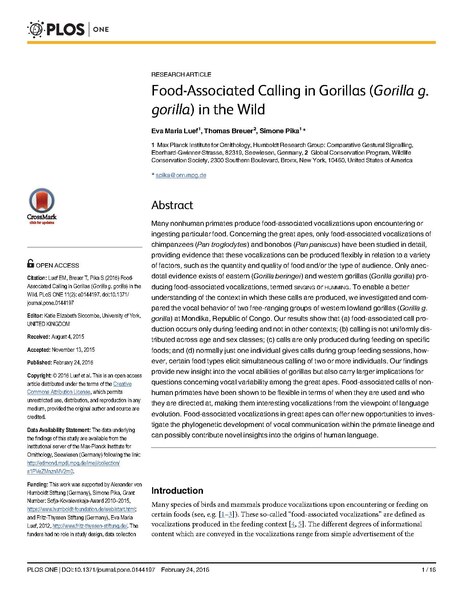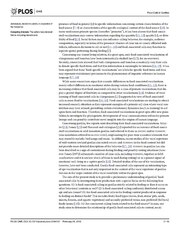File:Journal.pone.0144197.pdf

Original file (1,275 × 1,650 pixels, file size: 643 KB, MIME type: application/pdf, 16 pages)
Captions
Captions
Summary edit
| DescriptionJournal.pone.0144197.pdf |
English: Many nonhuman primates produce food-associated vocalizations upon encountering or ingesting particular food. Concerning the great apes, only food-associated vocalizations of chimpanzees (Pan troglodytes) and bonobos (Pan paniscus) have been studied in detail, providing evidence that these vocalizations can be produced flexibly in relation to a variety of factors, such as the quantity and quality of food and/or the type of audience. Only anecdotal evidence exists of eastern (Gorilla beringei) and western gorillas (Gorilla gorilla) producing food-associated vocalizations, termed singing or humming. To enable a better understanding of the context in which these calls are produced, we investigated and compared the vocal behavior of two free-ranging groups of western lowland gorillas (Gorilla g. gorilla) at Mondika, Republic of Congo. Our results show that (a) food-associated call production occurs only during feeding and not in other contexts; (b) calling is not uniformly distributed across age and sex classes; (c) calls are only produced during feeding on specific foods; and (d) normally just one individual gives calls during group feeding sessions, however, certain food types elicit simultaneous calling of two or more individuals. Our findings provide new insight into the vocal abilities of gorillas but also carry larger implications for questions concerning vocal variability among the great apes. Food-associated calls of nonhuman primates have been shown to be flexible in terms of when they are used and who they are directed at, making them interesting vocalizations from the viewpoint of language evolution. Food-associated vocalizations in great apes can offer new opportunities to investigate the phylogenetic development of vocal communication within the primate lineage and can possibly contribute novel insights into the origins of human language. |
| Date | |
| Source |
https://journals.plos.org/plosone/article?id=10.1371/journal.pone.0144197 https://doi.org/10.1371/journal.pone.0144197 |
| Author | Eva Maria Luef, Thomas Breuer, Simone Pika |
Licensing edit
- You are free:
- to share – to copy, distribute and transmit the work
- to remix – to adapt the work
- Under the following conditions:
- attribution – You must give appropriate credit, provide a link to the license, and indicate if changes were made. You may do so in any reasonable manner, but not in any way that suggests the licensor endorses you or your use.
File history
Click on a date/time to view the file as it appeared at that time.
| Date/Time | Thumbnail | Dimensions | User | Comment | |
|---|---|---|---|---|---|
| current | 17:50, 7 May 2020 |  | 1,275 × 1,650, 16 pages (643 KB) | Pamputt (talk | contribs) | Uploaded a work by Eva Maria Luef, Thomas Breuer, Simone Pika from https://journals.plos.org/plosone/article?id=10.1371/journal.pone.0144197 https://doi.org/10.1371/journal.pone.0144197 with UploadWizard |
You cannot overwrite this file.
File usage on Commons
There are no pages that use this file.
File usage on other wikis
The following other wikis use this file:
- Usage on www.wikidata.org
Metadata
This file contains additional information such as Exif metadata which may have been added by the digital camera, scanner, or software program used to create or digitize it. If the file has been modified from its original state, some details such as the timestamp may not fully reflect those of the original file. The timestamp is only as accurate as the clock in the camera, and it may be completely wrong.
| Short title | Food-Associated Calling in Gorillas (Gorilla g. gorilla) in the Wild |
|---|---|
| Author | Eva Maria Luef, Thomas Breuer, Simone Pika |
| Software used | Arbortext Advanced Print Publisher 11.0.2857/W Unicode-x64 |
| Conversion program | Acrobat Distiller 11.0 (Windows); modified using iTextSharp™ 5.5.3 ©2000-2014 iText Group NV (AGPL-version) |
| Encrypted | no |
| Page size | 612 x 792 pts (letter) |
| Version of PDF format | 1.4 |
